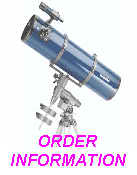Comet ISON - Late November 2013

- Comet ISON is currently 763 million kms from the SUN as at January 18th 2013
- Comet ISON is currently 650 million kms from the SUN as at March 26th 2013
- Comet ISON is currently 575 million kms from the SUN as at May 7th 2013
- Comet ISON is currently 639 million kms from the EARTH as at January 18th 2013
- Comet ISON is currently 526 million kms from the EARTH as at March 26th 2013
- Comet ISON is currently 451 million kms from the EARTH as at May 7th 2013
- Comet ISON's Tail is currently 64,000km in length as at March 26th 2013
- Comet ISON's Tail is currently 92,000km in length as at May 7th 2013
TELESCOPES
& ASTRONOMY
Last September a comet was discovered by 2 Russian amateur astronomers wading through photos taking by telescope run by ISON (International Scientific Optical Network). Early predications show the comet may be the brightest comet of all time! Early expectations show the comet could be visable during the day. It's important to note though that comets can be very unpredicable. On approach to the Sun, the comet can break up and become a fizzle instead of a sizzle!
BINOCULARS FOR OBSERVING COMETS



ORDERING
INFORMATION
MICROSCOPE GLOSSARY
Is Comet ISON a fizzle or a sizzle? - Report as at 15th November 2013
Working through the jumble of information on Comet ISON's visibility to observers, particularly in Australia, it appears up until yesterday that the comet has not brightened according to hopeful predictions made by enthusiasts.
This doesn't mean the comet has now been classified as a dud. Yesterday the comet decided to have a increase in "production rate" of materials being released from its surface. This has brightened the comet around one full magnitude, making it around magnitude 8. Magnitude 8 can only be seen from the darkest places on Earth with the unaided eye. However, a pair of binoculars, or small wide field telescope will show the comet. The bright Moon hampers efforts, particularly during the middle of November.
Comet ISON will continue to brighten until the 28th of November, although it will also be getting closer to the Sun. Twilight will be an increasing problem up until then. By the 24th of November, the comet will be 15° (roughly a hand's width, at arms length) from the Sun, but on the other hand, the comet will have brightened significantly. ISON may even be able to be seen during daylight!
Who's to say whether the comet will brighten another few magnitudes, before we are unable to see it, due to the Sun's proximity.
Comet ISON has travelled through the constellation Leo, and is currently in Virgo, heading straight towards the 15th brightest star in the sky - Spica. Spica is a magnitude 1.0, Blue Giant, Double Star, which is relatively easy to find if you have a Sky Chart, Planisphere or mobile sky app like Google Sky Map. ISON will skim past Spica on the 17th of November on its way towards Antares, another magnitude 1.0 star (17th brightest in the sky).
If possible, be in a position where the morning Sun is behind a obstruction (a hill etc.), while the comet is visible. This will help block out some of the Sun's light.
Michael Mattiazzo has a very user friendly Finder Chart.
COMET ISON FINDER CHART:
http://www.mattastro.com/ison/charts.html
As a comparison, Jupiter's distance is currently around 613 million kms away from the Sun.
Mars is currently around 95 million kms away from the Sun
- Comet ISON is currently 763 million kms from the Sun as at January 18th 2013
- Comet ISON is currently 650 million kms from the Sun as at March 26th 2013
- Comet ISON is currently 575 million kms from the Sun as at May 7th 2013
- Comet ISON is currently 639 million kms from the Earth as at January 18th 2013
- Comet ISON is currently 526 million kms from the Earth as at March 26th 2013
- Comet ISON is currently 451 million kms from the Earth as at May 7th 2013
The Comet's speed is around 72,720 km/hr, so travels about 1.75 million kms per day.
DOES ISON HAVE A TAIL YET, IF SO, HOW LONG IS IT?
Comet ISON's Tail is illuminated by the Sun and is currently more than 64,000km in length! Generally, Tails cannot be seen until a comet reaches the Inner Solar System (smaller than the radius of Jupiter's orbit).
Comets have 2 Tails. One is a Dust Tail and the other is an Ion Tail. The Dust Tail trails behind in the comet's orbit. Whereas, the Ion Tail is always trailing the comet, in a way that is directly opposite the Sun. This is due to the Sun's Solar Winds. Ionisation is responsible for Ion Tail being visible, and the tail tends to follow the Magnetic Field Lines rather than the Orbital Trajectory of the Dust Tail.
OBSERVATIONS
At this stage, due to it's great distance, you'll need a Reflecting Telescope which is at least 18" in diameter, or a Refracting Telescope of 12" or larger, and dark skies to even glimpse the comet at this stage. Long Exposure, with a sensitive Astrophotography Camera, will show the comet in smaller telescopes around a 10" Reflector.
As the comet gets closer, the best way of observing is with a pair of Binoculars. This is due to Binoculars having low magnification, and wide Field Of View. The low magnification ensures the image of comet ISON stays bright. High magnification spreads out the light too much.
Binoculars for observing Comet ISON
Comet ISON Finder Charts
Comet ISON has been imaged by the Deep Impact Spacecraft at a distance of 793 million kms.
The Deep Impact Spacecraft was launched in 2005 to study the Comet Tempel 1 by releasing an Impactor into the comet. This was successful, creating an impact crater, allowing photography of the inner part of the comet, and also recording the impact.
More about the Deep Impact Spacecraft
WHERE HAS THE COMET COME FROM?
Long Period Comets like ISON are thought to have originated from the Ort Cloud. The Ort Cloud is hypothesised sphere of billions of rock, dust and ice made objects, which surround the Solar System. It is the left over material from the formation of the Solar System. Every now and then, one of these objects moves from out of its stable orbit, and travels into the Solar System and traverses the Sun. Other Long Period Comets are Hale Bopp and Comet West.
WHAT TYPE OF COMET IS ISON?
Besides being a Long Period Comet, ISON is also known as a SunGrazer. This means ISON will get very close to the Sun, evaporating rapidly, and appearing exceptionally bright. The comet is not expected to survive its hairpin turn around the Sun.
END
ALL ABOUT
TELESCOPES
International Residents Please Call 61+ 8 8381 3188
Mobile 0416 123 096 or
Mobile 0402 681 288
VoIP 087 129 6316





